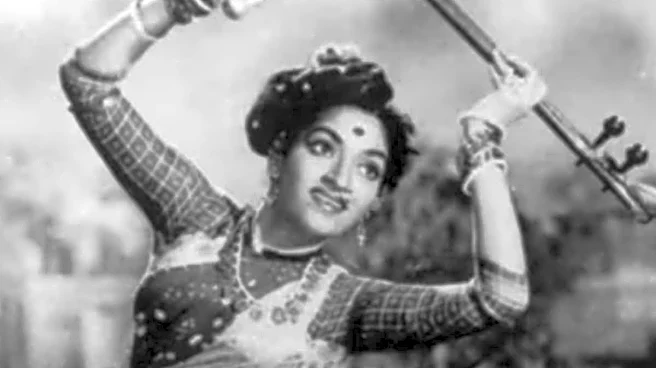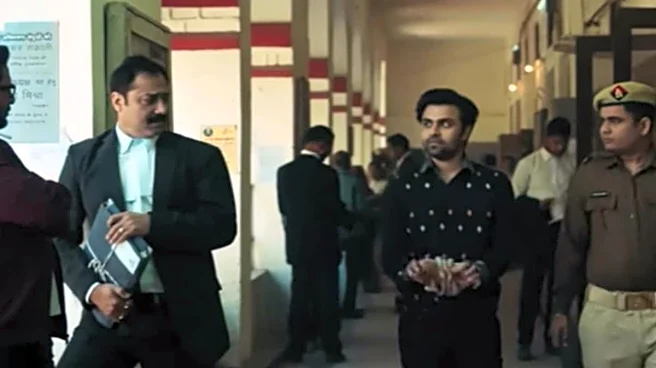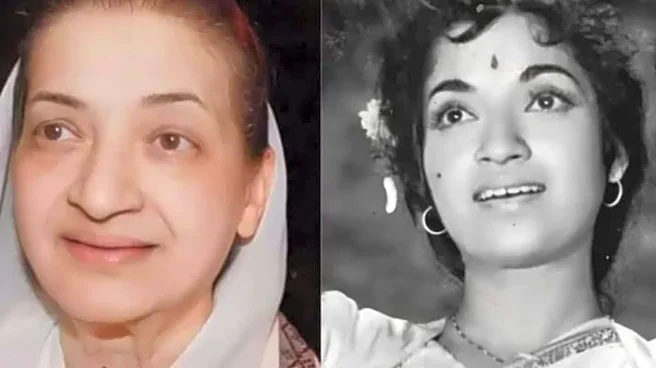Sandhya Shantaram, who passed quietly on October 4, 2025, belonged to that rare order of artists who seemed made of light rather than merely lit by it. Born Vijaya Deshmukh in Andhra Pradesh, she entered cinema almost by accident — and stayed to redefine what grace could look like on screen. Her journey, like her husband and collaborator V. Shantaram’s, was both improbable and inevitable: a story of discovery, devotion, and daring invention. Shantaram himself was one of Indian cinema’s great pioneers, a visionary who began directing silent films in the 1920s and kept reinventing form across decades. Long before Indian cinema found its modern vocabulary, he had already brought German prime lenses to his studio, experimented with extreme close-ups,
and used colour and light as moral languages. His Duniya Na Maane (1937) — a Marathi film about a young woman’s defiance against forced marriage — remains one of the earliest feminist landmarks on the Indian screen. For him, the camera was not just an observer; it was conscience itself. Before Sandhya entered his life, there was Jayshree, his partner and muse through the 1940s. Together they created works like Dr. Kotnis Ki Amar Kahani (1946), that rare Indo-Chinese collaboration of compassion and courage, and Parchhain (1952), a noir-tinged meditation on desire and loss. That last film brought Jayshree and the young Sandhya together — a symbolic relay between eras. The mentor’s lens had found its next reflection. When Shantaram met Sandhya, she was eighteen; he was fifty-five — a 37-year difference that would later inspire fascination and judgement in equal measure. But theirs was not a sentimental fairy tale; it was a creative covenant. He moulded her for the camera, but it was she who humanised his vision. What began as tutelage became collaboration, and what might have seemed a scandal ripened into one of Indian cinema’s most enduring artistic partnerships. Their first great blaze came with Jhanak Jhanak Payal Baaje (1955), one of the earliest Technicolor films made in India — a rapturous ode to the discipline and divinity of dance. Sandhya, who had no formal training, immersed herself under Gopi Krishna’s mentorship until her body learned the grammar of Kathak. The result was breathtaking. In the fiery Shiv Tandav, she matched him step for step, her precision a kind of prayer; and in ‘Nain So Nain Naahi Milao’, she turned stillness into melody, longing distilled into the curve of an eyelid. The film, with music by Vasant Desai and lyrics by Hasrat Jaipuri, swept honours — the National Film Award for Best Feature Film in Hindi, the Filmfare Award for Best Film, and the All India Certificate of Merit — and became a superhit at the box office. Yet its real triumph was Sandhya’s transformation: she had taught herself to dance, and in doing so, taught the camera to feel. Two years later, she became the living pulse of Do Aankhen Barah Haath (1957), the film that would carry Shantaram’s humane vision to the world. Based on a real-life experiment of reforming prisoners through trust and labour, it won the Silver Bear at the Berlin International Film Festival and a Golden Globe for Best Film Promoting International Understanding. In that austere landscape of moral redemption, Sandhya appears like a visiting spirit — a young woman selling wooden toys, guiding her cart through the fields, her ektara in hand. When she begins ‘Saiyan Jhooton Ka Bada Sartaj Nikla’, her voice, playful and teasing, drifts with the wind; the twang of the ektara threads through the sound of creaking wheels and rustling grass. The convicts, toiling in the open sun, pause as if startled by the memory of innocence. In her laughter, they rediscover what repentance cannot teach — joy. For those few minutes, punishment becomes play, and redemption is not imposed but felt. Later, in the hymn ‘Ae Malik Tere Bande Hum’, she stands still at the edge of the frame, embodying the compassion that words could not contain. Shantaram built a philosophy; Sandhya made it sing. Then came Navrang (1959) — the dream unbound. Here, Sandhya became both Jamuna and Mohini, wife and muse, mortal and illusion. It was her most audacious performance — and perhaps Shantaram’s most personal. In ‘Are Ja Re Hat Natkhat’, she performed the impossible six-matka dance, balancing earthen pots on her head while gliding through transformations of gender, mood, and magic. She becomes a bahurupiya, a trickster and shapeshifter — turning from coy girl to mischievous boy, from mortal to mythic. Her performance mocks illusion even as it perfects it. She is laughter, riddle, revelation. The film blurs dream and daylight, and Sandhya, with her composure and playfulness, becomes the hinge between them. By the 1960s, her art had ripened into quiet eloquence. In Sehra (1963), she stood against the desert wind, her eyes speaking the vocabulary of distance. In ‘Taqdeer Ka Fasana’, her face became the song itself — the camera catching longing in the tremor of stillness. And in Pinjara (1972), her Marathi triumph, she played Chandrakala, the Tamasha performer torn between art and virtue. It was perhaps her most self-reflective role: a woman celebrated and condemned for the very thing that made her luminous. Even behind the camera, Sandhya’s influence deepened. In Jal Bin Machhli Nritya Bin Bijli (1971), she helped conceive choreography and visual design, blending rhythm with spectacle. The irony was sublime: the woman who had once learned dance for a part now shaped the way Indian cinema danced with the camera. After Shantaram’s death in 1990, Sandhya remained the last custodian of Rajkamal Studios — its reels, sets, and memories. Visitors recall her walking through its dusty halls, pausing by props from Navrang, her face lit with a faint smile that combined mischief and melancholy. She had seen cinema when it was an act of faith — when colour meant conviction, and light had a conscience. In 1975, she received the Filmfare Award (Marathi) for Chandanachi Choli Ang Ang Jali, but she wore her honours lightly. Her true reward was endurance: to have been the dancer in Shantaram’s vision, the muse who steadied the camera’s dream. Sandhya Shantaram’s departure feels less like an ending than a dissolve — that slow, luminous fade her husband loved, where faces melt into memory and memory into myth. She was never the thunder of fame; she was its echo, the afterglow that stays when the reel stops spinning. Rajeev Srivastava is a filmmaker, writer, and photographer with a deep engagement in Indian cinema. He has taught film, curated two international film festivals at Siri Fort, and exhibited his photography at Bikaner House, New Delhi, in April 2025. Views expressed in the above piece are personal and solely those of the author. They do not necessarily reflect News18’s views.


/images/ppid_a911dc6a-image-175942265722772200.webp)





/images/ppid_a911dc6a-image-175957603100997671.webp)

/images/ppid_59c68470-image-175955752636054127.webp)


/images/ppid_a911dc6a-image-175957607228287519.webp)


